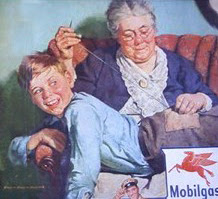- Critics have studied Norman Rockwell's work from many perspectives, but no one has analyzed Rockwell's role as a vehicle for vengeful gods dispensing karma.
- Behold the gods at work:
- In 1994, a wealthy couple bought a painting by Norman Rockwell. The couple spent a fortune because they admired Rockwell's talent and bonded with the painting which had "all the humor and artistic quality that Rockwell created in... his works.” Decades later, the couple discovered the painting was not by Rockwell but by illustrator Harold Anderson. Suddenly the painting's qualities disappeared in their eyes. The humiliated couple filed a lawsuit blaming the seller for not recognizing that the painting was an “open and obvious” forgery.
- In the 1950s Norman Rockwell's boss, the art director of The Saturday Evening Post, pressured Rockwell to give him several original paintings as a "gift" for the art director's personal collection. When Rockwell mustered the courage to ask for his paintings back, he received no reply. Other artists working for The Post complained that they were similarly pressured to "donate" their originals in order to stay on the art director's good side when he handed out new assignments. In this way, the art director amassed an art collection worth millions. He left that collection to his sons, thinking it would put them on easy street.
However, the inheritance turned out to be a curse. The sons bitterly squabbled over the paintings for the next 30 years. One was accused of manipulating his father to screw his brothers out of the art. Other brothers filed lawsuits claiming the father was mentally incompetent. The brothers accused each other of theft, misconduct, civil violations, liability for damages, etc. They sued each other again and again. By the time they had exhausted themselves and settled their feud, their lives were mostly over and their family was in tatters.
- In 1943, Rockwell created four pictures about people waiting to see President Franklin Delano Roosevelt. Rockwell admired Roosevelt and gave the pictures to Roosevelt's press secretary. For many years they hung on the walls of the White House to entertain the public. Then in 2017, descendants of Roosevelt's press secretary learned of the pictures and claimed they properly belonged to the family. Family members began fighting amongst themselves over who owned the pictures and who had authority to donate them to the White House. The newspapers noted that in the years of lawsuits that followed, the family tore itself apart over the art.
Rockwell was a thin, soft spoken man who lived for his art. He wasn't always good at defending his own interests. A casual observer might be forgiven for concluding that Rockwell was exploited by aggressive profiteers who saw an opportunity to feed on his talent and sacrifices.
Rockwell may have missed out on some of the money but ask yourself: which side ended up better off? Which side offered a more meaningful existence?
It seems the wrathful gods occasionally place artistic talent on earth as glittering bait to lure and trap the unworthy-- those who, lacking talent to make art, see only opportunities to exploit or profit from those who can.



